"Omelets & Others" March 25, 2010 - Volume 2 - Issue 06
|
|
|
Summer Store Hours start Monday, April 5th.
Closed Mondays
during the summer.
 |
|
|
Eggs-traordinary!
|
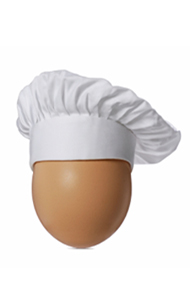 In
the pantheon of nearly perfect foods, eggs are at the top of the list!
Loaded with nutrition, inexpensive, low in calories, and quick to fix,
eggs are an extraordinary food source. Uniquely packaged, eggs are a
staple in everyone's refrigerator. In this issue we entertain you with
some fast facts about eggs, explain how to make the perfect omelet, and
describe a few other favorites. We finish with some scrumptious recipes
that will have you rediscovering this eggs-traordinary ingredient! In
the pantheon of nearly perfect foods, eggs are at the top of the list!
Loaded with nutrition, inexpensive, low in calories, and quick to fix,
eggs are an extraordinary food source. Uniquely packaged, eggs are a
staple in everyone's refrigerator. In this issue we entertain you with
some fast facts about eggs, explain how to make the perfect omelet, and
describe a few other favorites. We finish with some scrumptious recipes
that will have you rediscovering this eggs-traordinary ingredient!
|
March Special
|
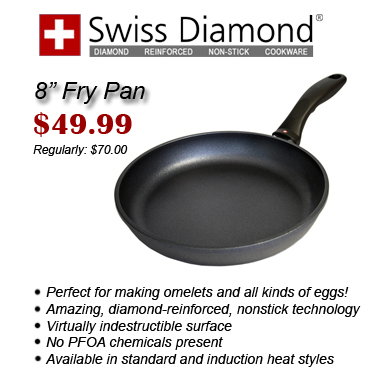
|
|
|
|
Did You Know This About That?
|
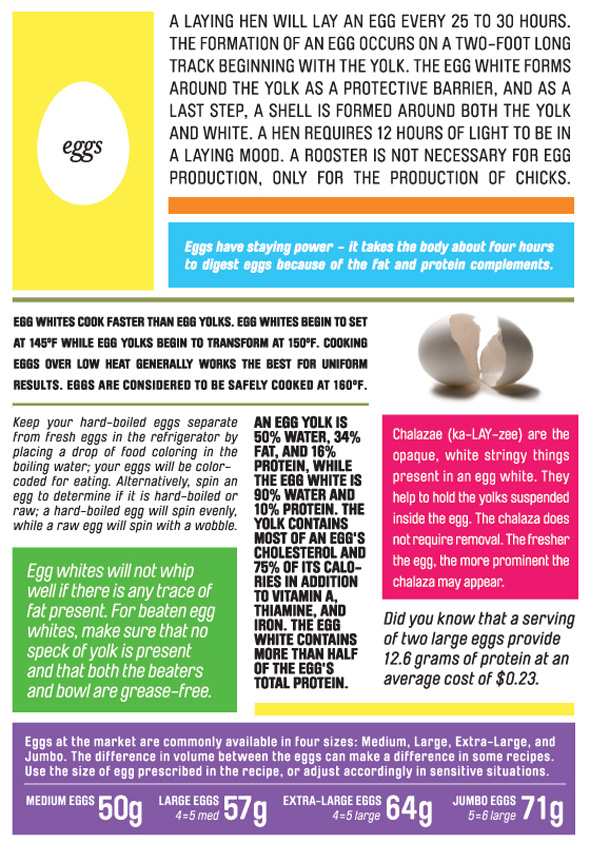 |
Eggs-cellent Omelets
|
For
breakfast, lunch, or dinner, an omelet is a great choice. French in
origin, an omelet is not nearly as difficult as some might like it to
appear. The secret to a great omelet is a great nonstick pan. An egg's
proteins coagulate at low temperatures, and are famous for making a pan
difficult to clean. A good nonstick pan alleviates many of the problems
with cooking eggs whether scrambled, fried, or as with an omelet.
Single-fold vs. Double-fold
- If you prefer, an omelet can be simply folded in half and slid onto a
waiting plate. A "single-fold" omelet works well when a lot of filling
is included inside the omelet.
|
Other Eggs-tras!
|
| Omelet Variations
Fill your omelets with delicious fillings according to your taste. Here are a few of our favorite combinations: 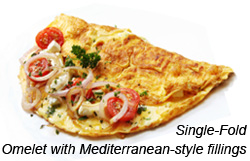
- Avocado, cheddar cheese, sour cream, salsa
- Brie, sautéed mushrooms, a sprinkle of thyme
- Mozzarella, diced pepperoni, and tomato sauce
- Chile con carne, cheddar cheese, sliced scallions
- Diced bell pepper, onion, zucchini
- Ham slice or dice, cheddar cheese
- Tomatoes diced, and a slather of prepared pesto
- Olive tapenade, diced tomatoes
Fluffy OmeletsSeparate
the eggs and beat the whites until soft peaks are formed. Carefully
fold in beaten yolks and pour the entire mixture into a heated pan. As
the eggs cook, the air bubbles will be captured, and an airy omelet
created.
Egg White OmeletsThese
omelets use just the white of the egg and are often preferred for those
desiring lower calories or lower fat intake. The egg whites may be
frothed, (not beaten, however), prior to adding to the heated pan. The 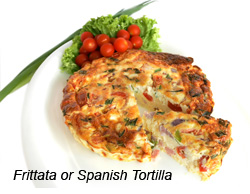 addition of herbs, tomatoes, or onion provides good flavor enhancements.
Frittatas and Tortillas
Cousins to the omelet, an Italian frittata, or a Spanish tortilla (see
featured recipe below) are similar egg dishes where additions,
(vegetables, meat, herbs, or your choice) are added to the egg mixture
prior to cooking. The result is a thick, pancake-like egg dish that is
flipped halfway during cooking. The "pie" is cut into wedges and
served. Two nonstick pans work well for inverting the frittata and
finishing the cooking. Use a 10-12-inch heavy-bottomed skillet.
Quiche 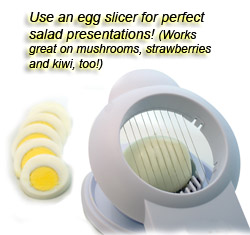 A
great quiche has a creamy, custard filling encased in a tender flaky
crust. Eggs are combined with milk and/or cream to form a custard-like
mixture. Additional ingredients - limited only by the imagination - are
added to the mixture or placed in a waiting pie shell. To prevent a
soggy crust, partially prebake the shell. Use a removable bottom quiche
pan or flan pan for easy presentation. Alternatively, a deep-dish pie
dish will perform well for delicious quiches.
Egg Tools
There are all
kinds of tools designed for helping enjoy eggs in every form! You'll
be inspired by the finds at our store including egg slicers for
beautiful salads, egg cups for beautiful presentations, pods for
perfect poaching, coddlers, egg rings, and so much more!
|
Smart Egg Tips
|
Tip #1: For
poached eggs, add a pinch of lemon juice or vinegar to the poaching
water; the acid will help coagulate the egg whites' proteins helping
the egg keep a better shape. Bring the water to a boil, but reduce to
barely a simmer once the eggs have been added.
Tip #2: When dyeing eggs,
add a teaspoon of vinegar to the water and food coloring mixture. The
vinegar's acid will dissolve some of the eggshell's calcium compounds
allowing for greater absorption of the color.

Tip #3:
Use pasteurized eggs for recipes that have an uncooked egg component.
The pasteurization process destroys any potential salmonella bacteria
potentially present in raw eggs. Some grocers will carry pasteurized
eggs, or, alternatively, egg substitutes sold in cartons are
pasteurized.
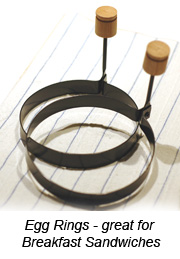 Tip #4:
When adding eggs to a hot mixture, temper them first by adding a small
amount of the hot mixture to the eggs, then add the warmed eggs to the
hot mixture. This will help prevent curdling and separation in the
final product. Tip #4:
When adding eggs to a hot mixture, temper them first by adding a small
amount of the hot mixture to the eggs, then add the warmed eggs to the
hot mixture. This will help prevent curdling and separation in the
final product.
Tip #5: An egg mixed with a
small amount of cream or water and brushed on breads, cookies, or
pastries will result in a lovely, shiny golden surface. An egg wash
will also help garnishes such as decorative sugars, nuts, or seeds
stick to the surface of pastries during baking.
Tip #6: Rinse raw egg from
cooking utensils under cold water. Hot water will cook the egg's
protein binding it to the utensil's surface.
Tip #7:
An egg that floats in water is a very old egg and should not be eaten.
The egg floats because the air cell located in the rounded end of the
egg gains air and size as the egg ages providing buoyancy.
|
Q & A's
|
 Q: Some eggs tout extra Omega-3 and Omega 6 compounds, ho Q: Some eggs tout extra Omega-3 and Omega 6 compounds, ho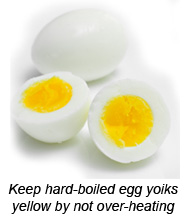 w are these eggs different? w are these eggs different?
A:
Chickens fed flax seed produce eggs with greater quantities of Omega-3
and Omega-6 compounds, essential fatty acids. Flax is high in these
compounds and transfer to the egg through the chicken's feed. Omega
compounds are thought to have health benefits in triglyceride and
cholesterol management.
Q: How can I keep boiled eggs from having a green-tinged yolk?
A:
The green color around the yolk of a hard-cooked, boiled egg comes from
too much heat. The yolk is high in proteins that when exposed to too
high of a temperature for too long interact with the yolk's sulfur
compounds creating a green color. To avoid this, start hard-boiled eggs
in cool water, allow the pot to come just to a boil, then remove from
the heat. Cover the pot and allow the eggs to stand 15 minutes in the
hot water. Cool the eggs in a cold bath water and peel, or refrigerate.
Q: What is the best way to store eggs?
A:
Eggs may be kept at room temperature for a few days, but degrade
quickly. Refrigeration extends the shelf life of an egg greatly. The
ideal storage temperature for eggs is 40ºF. Avoid storing eggs in the
door of the refrigerator, which is typically warmer than the central
compartments. Store eggs in their original cardboard carton; it helps
to maintain a higher humidity environment while reducing odor
absorption.
Q: My omelets are not turning out - what's wrong?
 A:
There are some common issues that arise when making omelets. Here are
some troubleshooting tips: (1) If the bottom is browning, but the top
is still wet: use a lower heat setting that allows for more even
cooking. (2) If the omelet can't be folded, there may be too many eggs
for the size of pan. For an 8-inch pan, use a maximum of 3 eggs; for a
10-inch pan, use a maximum of 5 eggs. Also use a modest portion of
filling for good folding. (3) If the omelet is sticking to the pan, use
a good quality nonstick pan. Keep loosening the omelet from the bottom
of the pan during early stages of cooking. A little butter added to the
pan will help with sticking and will add a flavor boost.uminum pans by hand, and never in
the dishwasher. A:
There are some common issues that arise when making omelets. Here are
some troubleshooting tips: (1) If the bottom is browning, but the top
is still wet: use a lower heat setting that allows for more even
cooking. (2) If the omelet can't be folded, there may be too many eggs
for the size of pan. For an 8-inch pan, use a maximum of 3 eggs; for a
10-inch pan, use a maximum of 5 eggs. Also use a modest portion of
filling for good folding. (3) If the omelet is sticking to the pan, use
a good quality nonstick pan. Keep loosening the omelet from the bottom
of the pan during early stages of cooking. A little butter added to the
pan will help with sticking and will add a flavor boost.uminum pans by hand, and never in
the dishwasher. |
|
Cookbook Review
|
Eggs by Michel Roux. Photography by Martin Brigdale. Copyright 2005. Published by John Wiley & Sons, Inc., Hoboken, NJ.
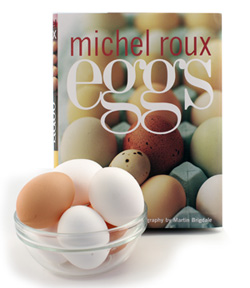 We
thought we knew eggs pretty well, but Chef Roux presents a decidedly
French perspective on this ubiquitous food that opens us to a new world
of flavors and interpretations. Michel Roux clearly has a reverent
respect for eggs in all forms and generously shares his secrets for
coaxing great flavor from this everyday ingredient. He states, "Like
bread, eggs are one of life's most basic and indispensable foods." He
includes all the fundamentals for eggs - boiling, poaching, frying,
scrambling, and baking. From this knowledge base, he explores a myriad
of dishes where eggs are the primary ingredient, and others where eggs
provide the essential distinctiveness to the dish as with soufflés,
custards, meringues, pasta, and many others. His personal recipes range
from eggs as the entrée to eggs as appetizers, snacks, or desserts.
You'll find authentic recipes for such classics as Quiche Lorraine
(featured below), and Classic Gruyère Soufflé, but you'll also find
some creative inspiration as with his Pear & Cinnamon Omelet or
Pistachio Crème Brûlée, and many others. The full-color photography
generously placed throughout the book is a beautiful complement to the
recipes. You'll find this book an enticing, magnificent homage to the
humble egg. We
thought we knew eggs pretty well, but Chef Roux presents a decidedly
French perspective on this ubiquitous food that opens us to a new world
of flavors and interpretations. Michel Roux clearly has a reverent
respect for eggs in all forms and generously shares his secrets for
coaxing great flavor from this everyday ingredient. He states, "Like
bread, eggs are one of life's most basic and indispensable foods." He
includes all the fundamentals for eggs - boiling, poaching, frying,
scrambling, and baking. From this knowledge base, he explores a myriad
of dishes where eggs are the primary ingredient, and others where eggs
provide the essential distinctiveness to the dish as with soufflés,
custards, meringues, pasta, and many others. His personal recipes range
from eggs as the entrée to eggs as appetizers, snacks, or desserts.
You'll find authentic recipes for such classics as Quiche Lorraine
(featured below), and Classic Gruyère Soufflé, but you'll also find
some creative inspiration as with his Pear & Cinnamon Omelet or
Pistachio Crème Brûlée, and many others. The full-color photography
generously placed throughout the book is a beautiful complement to the
recipes. You'll find this book an enticing, magnificent homage to the
humble egg.
|
|
Three Tasty Egg Recipes
|
Recipes excerpted from Eggs
by Michel Roux. Copyright 2005. Published by John Wiley & Sons,
Inc., Hoboken NJ. Reprinted with permission of the publisher. All
rights reserved.
Scrambled Eggs Masala
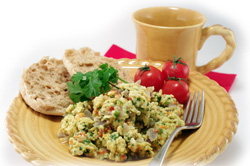 Making
scrambled eggs will never be quite the same once you try this
variation. A few simple additions to a basic mixture of eggs and milk
turn everyday fare into an extraordinary moment. There's something
about the flavors of the onion and cilantro that bring out the best of
the eggs in this scrambled dish. Making
scrambled eggs will never be quite the same once you try this
variation. A few simple additions to a basic mixture of eggs and milk
turn everyday fare into an extraordinary moment. There's something
about the flavors of the onion and cilantro that bring out the best of
the eggs in this scrambled dish.
Click here to view the full, illustrated recipe.
Click here for a printable version of the recipe. (PDF format)
Spanish Tortilla with Chorizo
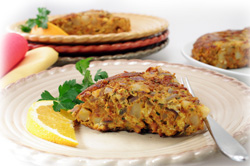 In
Italy this would be called a frittata, here the chorizo characterizes
the dish and shifts it to a different country of origin, Spain. Over an
inch in height, and bursting with flavor, this is a hearty egg dish
that would fit equally as well at the brunch buffet or as the featured
entrée in a rustic supper. Seconds were had by all! In
Italy this would be called a frittata, here the chorizo characterizes
the dish and shifts it to a different country of origin, Spain. Over an
inch in height, and bursting with flavor, this is a hearty egg dish
that would fit equally as well at the brunch buffet or as the featured
entrée in a rustic supper. Seconds were had by all!
Click here to view the full, illustrated recipe.
Click here for a printable version of the recipe. (PDF format)
Quiche Lorraine
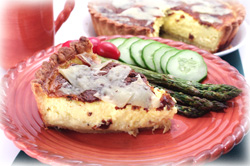 For
a while, we all over did it on quiche. But, it's time to rediscover
what makes quiche so popular. This classic recipe for Quiche Lorraine
has all of the original richness included, and what a difference it
makes in the results! Each bite invited savoring and deliberate
enjoyment. Serve with a garden salad for the perfect lunch or supper. For
a while, we all over did it on quiche. But, it's time to rediscover
what makes quiche so popular. This classic recipe for Quiche Lorraine
has all of the original richness included, and what a difference it
makes in the results! Each bite invited savoring and deliberate
enjoyment. Serve with a garden salad for the perfect lunch or supper.
Click here to view the full, illustrated recipe.
Click here for a printable version of the recipe. (PDF format)
|
 |
Plan an "eggs-hilarating" time in your kitchen for sometime soon!
|
|
Lorraine, Katie, and all of the Staff at Beyond Pots and Pans
|
|
|
|
|